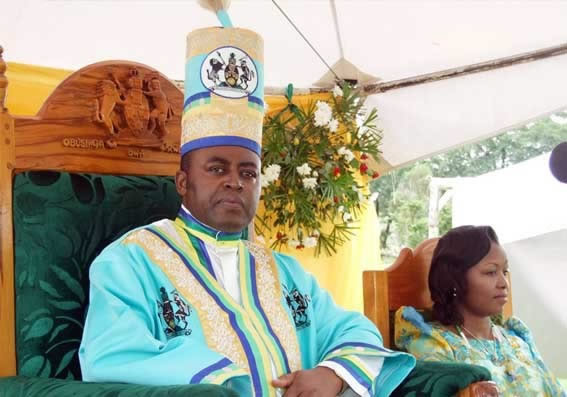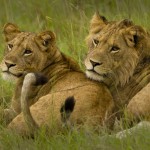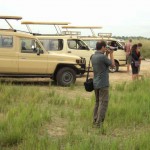
Origins
The Bakonjo and Bamba are Bantu and they are said to have a common origin with the other Bantu groups.The Bakonjo are found in the District of Kasese. They are the most numerous of the Rwenzori peoples, being more than the Bamba or the Bambuti. Physically they are generally short and stout. Legend has it that the Bakonjo once lived on Mount Elgon in eastern Uganda and that during the Kintu migration, the Bakonjo came with Kintu and other peoples to Buganda. However, rather than settle in Buganda, the Bakonjo decided to continue and settle in the western highland s of Mount Rwenzori which has a climate similar to that of Mount Elgon where they had originally lived. This is said to have been around A.D 1300. Another tradition asserts that the Bakonjo have lived on Mount Rwenzori from time immemorial and that they have no foreign place of origin. This tradition asserts that the ancestor of the Bakonjo emerged from the caves of Mt.Rwenzori and produced the rest of the Bakonjo. This tradition however is too simplistic to be generally accepted. What could best be said is that since the Bakonjo are Bantu speaking, they could trace their origin to the Congo region where the other Bantu groups originated.
Marriage
Marriage among the Bakonjo and Bamba was a matter of great social concern. It was usual for families to book spouses early in life. Often the booking would be done on the day the boy was initiated. No marriage could be socially recognized unless bride wealth obligations had been settled. The bride wealth was normally paid in form of goats. The number of goats was determined by the economic status of the families concerned. In addition to the number of goats, a digging stick and an animal skin had to be included. The digging stick would replace the girl’s lost labour and the skin would replace one used by the girl when young. In modern times, a hoe and a blanket have replaced the digging stick and the skin. Divorce was rare but in the event of it, all the goats given as bride wealth would be given back. All un married girls were supposed to be virgins. If a girl conceived before marriage, she would be executed.
Initiation
The Bakonjo share some elements of culture with the Bamba. One such element was the initiation. The purpose of initiation was to transform the initiates from childhood to adulthood. Therefore all the male children, before or after reaching puberty, had to undergo circumcision. This was conducted jointly by the Bakonjo and the Bamba. The ceremony would normally begin in Bwamba and then end in Bukonjo. The initiation ceremony was conducted after long intervals, often fifteen to seventeen years. It involved all male children from the age of three years.
Religion
The Bakonjo believed in two supreme beings; Kalisa and Nyabarika. kalisa was viewed as a monster with one arm, one eye, one leg, one ear, half nose and half for the rest of the body. Kalisa was a half man. The exact structure of Nyabarika is not known. He is believed to be the most powerful spiritual being. He had the power to heal, kill, haunt, provide fertility or cause barrenness and, indeed, make hunting expeditions successful or otherwise. Therefore, Nyabarika had to be pleased. Kalisa was regarded as being very important mainly with respect to hunting. Since hunting was a cherished occupation among the Bakonjo, one can tell the power and importance of Kalisa too.
On the southern and eastern slopes of Rwenzori Mountain, the Bakonjo used to construct shrines dedicated to Kalisa and Nyabarika. Such shrines would be made of Bamboo sheaths. They were too small for a man to enter. They are said to have been numerous in the Bamboo zones of the Nyamagasani and Nyamwamba rivers. They were rare in Mubuku and Bujuku valleys. The shrines were huts built in pairs. The larger huts were slightly over one meter high. A food offering of matooke or chicken, was placed on the stakes between the two huts.
Hunting
Hunting was a very important activity among the Bakonjo. Although it was enjoyed as sport, more importantly, it was a source of food. Skilled hunters occupied a place of importance in the society. The main instruments of hunting included spears, hunting nets, bows and arrows and ropes. The Bakonjo also kept dogs.
Hunting was done on a small as well as large scale. Hunters included trappers who operated as individuals; occasional hunters in groups of two or as individuals; but the most interesting and well-organized hunters formed hunting troops. The troops could consist of as many as thirty to sixty people. There were rules and regulations concerning the conduct of the hunting expeditionand the sharing of the meat.
Before setting off on a hunting trip, supplications and sacrifices were offered to Kalisa and Nyabalika for the success of the hunting expedition. If the expedition was successful, some pieces of meat were left at the slaughtering place. A small fence of bamboo stakes was constructed across the hunting path to bar any angry spirits from following the hunting party. Should a person use the path, he would cast a handful of green leaves over Bamboo stakes so that the said spirits would not follow him.
Secret communication
The Bakonjo had a system of secret communication used within families. This art was strictly a father to son affair. The conversation was done through whistling. The whistling was of a peculiar quality, not loud but deeply penetrating. This method of communication was used during hunting to convey messages like “The animals are trying to turn buck”; “The dogs have been sent for”; “The monkeys have come to the ground on the other side of the river”; Messages could go as far as one kilometer away. This type of communication is said to have been so peculiar to the Bakonjo that their immediate neighbors, the Bamba and the Batooro could not understand it.
Economy
The Bakonjo are agriculturalists. They grow mainly matoke, yams, potatoes, cassava and beans. At a later time, they took up coffee and cotton growing. In addition, they rear goats, sheep and fowls. Production was initially subsistence and they supplemented their produce by hunting and fishing on Lakes Edward and George.

 Posted in
Posted in 

